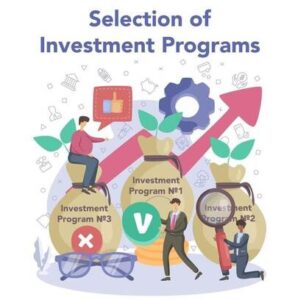GROW WISER.
THRIVE STRATEGICALLY.
Unlocking Financial Frontiers: Crypto, ISAs, Pensions, and Beyond!
Welcome to a realm where financial horizons expand—where crypto, ISAs, pensions, and more converge in a treasure trove of insights, tips, and hacks. Be with us as we navigate these frontiers, unraveling the secrets to financial empowerment and wealth management.
Note: Remember, investing carries risks. Seek advice from certified professionals before making any decisions. Our content is informative, not personalised advice. We’re not liable for any financial outcomes.
What is investing?
Investing is an art and science that opens the doors to financial growth and security. Whether you’re a novice exploring the investment landscape or an experienced player seeking to expand your portfolio, understanding the fundamentals is crucial.

Investment Strategies
Investment strategies serve as blueprints guiding individuals toward their financial goals. From conservative approaches to aggressive tactics, a spectrum of strategies exists:
Long-Term Investing: This strategy involves buying and holding assets for an extended period, leveraging the power of compounding and weathering market fluctuations.
Value Investing: Focuses on identifying undervalued assets with growth potential, following principles championed by renowned investors like Warren Buffett.
Diversification: Spreading investments across different asset classes mitigates risk, with the adage of “not putting all eggs in one basket” being a core principle.

Types of Investments
Investing encompasses a multitude of avenues, each with its risk-return profile:
Stocks: Ownership shares in companies, offering potential growth but also volatility.
Bonds: Fixed-income securities representing debt, providing steady income but with varying levels of risk.
Real Estate: Physical property ownership with potential for appreciation and rental income.
Mutual Funds: Pooled investments across various assets, managed by professionals for diversification.
ETFs (Exchange-Traded Funds): Similar to mutual funds but traded on exchanges, providing diversification and flexibility.
Commodities: Investment in tangible goods like gold, oil, or agricultural products, susceptible to market fluctuations.
Risk Management
Risk is inherent in investing, but effective risk management is key:
Asset Allocation: Balancing investments across different asset classes to manage risk exposure.
Research and Due Diligence: Thoroughly researching investments before committing capital mitigates risks associated with unknown factors.
Diversification: Spreading investments across different assets cushions against losses in any single investment.
Emergency Fund: Maintaining a cash reserve for unforeseen circumstances prevents the need to liquidate investments in emergencies.

Investing for beginners: What to choose?
For those taking their initial steps into the world of investing, the multitude of options may seem daunting. Starting this journey requires thoughtful consideration and a clear understanding of key principles before diving into specific investment types.
Define Your Objectives
Begin by defining your financial goals and aspirations. Are you investing for long-term wealth accumulation, saving for a particular milestone, or seeking regular income? Understanding these objectives helps shape your investment strategy.
Read More >>
Risk and Return Balance
One fundamental concept in investing is the trade-off between risk and return. Investments with higher potential returns typically come with higher risks. Consider your risk tolerance – how comfortable you are with potential fluctuations in the value of your investments.
Time Horizon and Patience
Your investment horizon, or how long you intend to keep your investments, is crucial. Longer horizons might allow for more aggressive strategies, while shorter ones may require more conservative approaches. Remember, successful investing often requires patience and a long-term perspective.
Diversification: Spreading the Risk
Diversification involves spreading your investments across different asset classes to reduce risk. This strategy helps mitigate losses from any single investment. It’s like the age-old saying of not putting all your eggs in one basket.
Continuous Education
Keep learning and expanding your investment knowledge. Utilize various resources such as books, courses, reputable online platforms, and advice from financial experts. Understanding the basics of investing is empowering and crucial for making informed decisions.
Start Small, Stay Consistent
Begin with an amount you’re comfortable with, even if it’s small. Consistency in investing, regardless of the amount, can yield significant results over time due to the power of compounding.
Entering the investment landscape as a beginner requires patience, education, and a clear strategy. By defining your objectives, balancing risk and return, understanding the importance of time horizon and diversification, continuously educating yourself, and starting small but consistent, you lay the groundwork for a successful investment journey.
CRYPTO Currencies
Digital Wallet or Money
Cryptocurrencies are digital currencies that use cryptographic technology for secure transactions. They operate on decentralized networks called blockchains, ensuring transparency, security, and a peer-to-peer transaction system. Bitcoin, introduced in 2009, was the first decentralized cryptocurrency, paving the way for thousands of others, each with unique features and purposes.

Read More >>
Embarking into the World of Cryptocurrencies
Cryptocurrencies have propelled into the financial scene, stirring a global frenzy with their diverse range and potential impact. This burgeoning realm encompasses an array of digital assets, each exhibiting distinct traits and harboring significant potential across various sectors. Let’s delve into the multifaceted universe of cryptocurrencies to unravel their essence and profound implications.
1. The Essence of Cryptocurrencies
Cryptocurrencies fundamentally represent digital or virtual tokens secured by cryptographic techniques, safeguarding them against fraudulent activities like counterfeiting or double-spending. Unlike conventional fiat currencies issued by central authorities such as governments or banks, cryptocurrencies operate independently, fostering a decentralized ecosystem. This decentralized nature empowers users, enabling them to maintain control over their financial transactions and facilitate direct peer-to-peer exchanges without the need for intermediaries.
2. Popular Cryptocurrencies
The world of cryptocurrencies hosts an extensive array of digital tokens, each distinguished by its unique features and utilities:
Bitcoin (BTC): Serving as the trailblazer in the cryptocurrency domain, Bitcoin boasts decentralized features, a capped supply, and steadily increasing adoption.
Ethereum (ETH): Beyond a mere cryptocurrency, Ethereum functions as a platform supporting Ether and a diverse spectrum of decentralized applications (dApps), ushering in innovations in smart contracts and decentralized finance (DeFi).
Tether (USDT): Positioned as a stablecoin, Tether is pegged to the value of the US dollar, ensuring stability amid the notorious volatility within the cryptocurrency market.
Binance Coin (BNB): As the native token of the Binance exchange, BNB offers a multitude of functionalities, including discounts on trading fees, participation in token sales, and various platform utilities.
USD Coin (USDC): Another prominent stablecoin, USDC, operates in compliance with regulatory standards, serving as a reliable digital asset pegged to the value of the US dollar.
3. Mechanism Behind Cryptocurrencies
Cryptocurrencies derive their security and operational efficiency from blockchain technology, an immutable and decentralized ledger system. This innovative technology records transactions transparently across a network of nodes, ensuring cryptographic security and eliminating the need for intermediaries. Each block of data, cryptographically linked to the preceding one, forms a chain, thereby creating a tamper-resistant and transparent record of transactions.
4. Investment Opportunities and Risks
While the cryptocurrency market presents tantalizing investment prospects, it’s crucial to acknowledge the inherent risks:
Volatility: Cryptocurrencies are notorious for their price volatility, often experiencing significant fluctuations within short time frames, posing risks for investors.
Regulatory Uncertainty: The regulatory landscape surrounding cryptocurrencies is continually evolving, and changes in regulations could significantly impact the market dynamics and adoption.
Technological Risks: Given the nascent stage of cryptocurrency systems, technical vulnerabilities or glitches could potentially compromise the security or functionality of these digital assets.
5. Regulatory Environment and Future Outlook
Governments and regulatory bodies worldwide are actively navigating the regulatory frameworks for cryptocurrencies. While some jurisdictions embrace innovations with caution, others seek to provide a conducive environment for cryptocurrency adoption. The future trajectory of cryptocurrencies heavily hinges on the establishment of clear, comprehensive, and pragmatic regulatory frameworks that balance innovation and consumer protection.
6. Practical Applications and Real-World Use Cases
Beyond speculative investments, cryptocurrencies are finding practical applications across diverse sectors:
Digital Payments: Cryptocurrencies facilitate seamless and borderless transactions, enabling users to transfer funds globally with minimal fees and without the need for traditional banking systems.
Decentralized Finance (DeFi): Leveraging blockchain technology, DeFi platforms offer a gamut of financial services such as lending, borrowing, and trading without the intervention of centralized authorities.
Supply Chain Management: Cryptocurrencies aid in enhancing transparency and traceability within supply chains, ensuring authenticity and efficiency in tracking goods.
Non-Fungible Tokens (NFTs): NFTs represent unique digital assets, certifying ownership and authenticity, particularly in the realms of digital art, collectibles, and gaming.
7. Security and Best Practices
Navigating the cryptocurrency landscape necessitates stringent security measures:
Secure Wallets: Utilize reputable and secure wallets to store cryptocurrencies, prioritizing safety and implementing robust security features.
Password Management: Employ strong, unique passwords for cryptocurrency-related accounts, ensuring protection against unauthorized access.
Scam Awareness: Exercise vigilance and caution when encountering unsolicited offers or links, remaining wary of potential scams prevalent within the cryptocurrency space.
Staying Informed: Continuously educate oneself on evolving security practices, staying abreast of the latest trends, and engaging with credible sources for information updates.
8. Community Engagement and Resources
The cryptocurrency community serves as a hub for knowledge exchange and support:
Online Forums: Actively engage and participate in online communities and forums to gain insights, share experiences, and remain updated on the latest developments.
Expert Insights: Stay informed by following reputable cryptocurrency news sources, industry experts, and influencers offering valuable insights and analysis.
Research and Due Diligence: Conduct thorough research and due diligence before investing in any cryptocurrency or participating in new projects or ventures.
Professional Guidance: Consider seeking advice and guidance from certified financial advisors or experts specializing in cryptocurrencies to make informed decisions aligned with your financial goals.
As the cryptocurrency landscape evolves, grasping its fundamental principles, potential opportunities, and associated risks is paramount for informed decision-making. By prioritizing security measures, fostering continuous learning, and actively engaging within the community, individuals can confidently navigate this transformative realm and contribute to its progressive evolution.
Expert Tips for Safe Cryptocurrency Investments
Investing in cryptocurrencies can be a rewarding endeavor, but it’s crucial to navigate this dynamic market with caution. Here are key strategies to make informed decisions and safeguard your investments.
Thoroughly Research Cryptocurrency Exchanges
With a plethora of exchanges available, choosing the right one is paramount. Extensive research, reviews from seasoned investors, and understanding each platform’s nuances are essential steps before committing funds. Consider factors like security measures, user-friendliness, and available currencies on the exchange.
Mastering Digital Currency Storage
After acquiring cryptocurrencies, secure storage is vital. Whether stored in an exchange or a digital wallet, each option comes with its intricacies and security protocols. Exploring diverse wallet types, understanding their technical aspects, and aligning them with your security preferences is crucial to safeguarding your digital assets.
Embrace Investment Diversification
The principle of diversification rings true in the cryptocurrency realm. Avoid placing all investments in a single cryptocurrency, even if Bitcoin seems alluring. Explore the multitude of options available, spreading investments across various currencies to mitigate risks and capitalize on different market trends.
Prepare for Market Volatility
The crypto market is renowned for its volatility, characterized by significant price fluctuations. Be mentally prepared for these roller-coaster price swings. If such market fluctuations adversely impact your investment strategy or emotional well-being, reconsider your exposure to cryptocurrencies.
Exercise Caution with Speculative Investments
While cryptocurrencies garner immense attention, they remain speculative and relatively nascent. Investing in emerging assets demands a conservative and well-informed approach. Conduct comprehensive research, understand the market dynamics, and initiate investments cautiously to mitigate potential risks.
Cryptocurrencies offer promising opportunities, yet their speculative nature necessitates careful consideration and thorough preparation. Prioritize research, diversification, and an informed investment approach to navigate this evolving market landscape.
Cash ISA
A Guide to Getting Started
Welcome to your guide on Cash ISAs, the gateway to tax-efficient saving. Throughout this journey, we’ll unravel the world of Cash ISAs, empowering you with insights and strategies to start and grow your investments wisely.
In this guide, we’ll explore the fundamentals, benefits, and strategies surrounding Cash ISAs, offering you a roadmap to secure your financial future. From understanding the basics to maximizing the potential of these accounts, let’s embark on this enriching journey together.
Get ready to discover the power of tax-free savings and unlock new possibilities for your financial well-being through Cash ISAs.

Chapter 1: Understanding Cash ISAs
What Are Cash ISAs?
Cash ISAs, or Individual Savings Accounts, are tax-efficient savings accounts available in the UK. These accounts allow individuals to save or invest money without paying income tax on the interest earned. They serve as a flexible and accessible tool for growing savings, catering to various financial goals.
Benefits of Cash ISAs:
Tax-Free Interest: One of the primary advantages of Cash ISAs is the tax-free interest earned on savings, providing an opportunity to maximize returns without the burden of taxation.
Flexibility: Cash ISAs offer flexibility in terms of access to funds. With options like instant access, fixed-rate, and innovative finance ISAs, investors can choose accounts aligning with their liquidity needs and goals.
Security and Stability: These accounts are backed by the Financial Services Compensation Scheme (FSCS), ensuring protection for deposits up to a certain limit, providing a level of security for savers.
Types of Cash ISAs:
Instant Access Cash ISA: This type allows immediate access to funds without penalties, making it suitable for emergency funds or short-term savings.
Fixed-Rate Cash ISA: Fixed-term accounts offering higher interest rates but with a lock-in period, ideal for individuals seeking guaranteed returns over a specified period.
Innovative Finance ISA: These ISAs facilitate peer-to-peer lending or investing in crowdfunding platforms, potentially offering higher returns but with increased risk.
Understanding these variations allows investors to choose accounts that align with their financial objectives and risk tolerance, optimizing their savings strategy.
Read More >>
Chapter 2: Getting Started with Cash ISAs
Eligibility and Contribution Limits:
To open a Cash ISA, you must be a UK resident over the age of 16 for a Cash ISA or 18 for a Stocks and Shares ISA. Additionally, there’s an annual contribution limit set by the government. As of the current tax year, the ISA allowance is £20,000, allowing individuals to invest up to this amount across various ISAs.
Selecting the Right Cash ISA:
Understanding Your Needs: Assess your financial goals, whether it’s short-term saving, long-term investment, or a blend of both.
Interest Rates and Terms: Compare interest rates and terms offered by various Cash ISAs. Fixed-rate ISAs provide stable returns, while variable rates might offer flexibility.
Accessibility: Consider how easily you may need to access your funds. Instant access ISAs offer flexibility, while notice accounts might offer higher interest rates but require advance notice for withdrawals.
Opening a Cash ISA Account:
Research and Comparison: Research different ISA providers, comparing interest rates, terms, and customer service reviews.
Gather Required Documents: Prepare necessary identification and proof of address documents as per the provider’s requirements.
Contact the Chosen Provider: Reach out to the selected ISA provider to initiate the application process. This can often be done online or by visiting a branch.
Completing the Application: Fill in the required details accurately and submit the necessary documents as per the provider’s instructions.
Upon successful completion of the application, your Cash ISA account will be set up, providing you with a tax-efficient platform to start your savings or investments.
“A Cash ISA functions as a tax-free savings account, allowing you to earn interest without any tax liability. In the 2023/24 tax year, individuals aged 16 or above can invest up to £20,000 in a Cash ISA. This comprehensive guide assists in determining the necessity of an ISA for your financial goals and provides a curated selection of top ISA options available.”
Chapter 3: Maximizing Your Cash ISA Investment
Managing Your ISA Portfolio:
Diversification: Consider diversifying your Cash ISA portfolio by allocating funds across different types of ISAs. Balancing between instant access, fixed-rate, and innovative finance ISAs can optimize returns while managing risk.
Regular Reviews: Periodically assess your ISA portfolio’s performance. Rebalancing or adjusting allocations can ensure alignment with your evolving financial goals.
Understanding Interest Rates:
Fixed vs. Variable Rates: Fixed-rate Cash ISAs offer a predetermined interest rate for a specified term, providing stability. Variable-rate ISAs can offer flexibility but are subject to market fluctuations.
Introductory Rates: Some ISAs might offer higher introductory rates which could change after a specific period. Understanding these terms is crucial to anticipate future returns.
Reviewing and Switching ISAs:
Regular Assessment: Review your ISA periodically to ensure it meets your financial objectives. If the current ISA doesn’t align with your goals or offers lower rates, consider switching.
Switching Procedures: Research potential ISA providers, compare rates, terms, and potential charges for transferring. Follow the transfer process provided by the new ISA provider to switch accounts smoothly.
Maximizing your Cash ISA investment involves not only optimizing returns but also ensuring alignment with your financial aspirations. By managing your portfolio, understanding interest rates, and reviewing options regularly, you can leverage the potential of Cash ISAs for your financial well-being.
Chapter 4: Tips for Long-Term Success
Setting Financial Goals:
Clarity in Objectives: Define clear and achievable financial goals when utilizing Cash ISAs. Whether it’s saving for a house deposit, retirement, or a dream vacation, outlining specific objectives helps direct your savings strategy.
Timeframe and Prioritization: Determine the timeframe for each goal and prioritize them according to urgency and importance. Aligning your ISA investments with these goals can provide a roadmap for effective savings.
Regular Monitoring and Reviewing:
Frequent Assessment: Consistently monitor your Cash ISA performance in line with your financial objectives. Regular reviews allow you to adjust strategies, reallocate funds, or switch ISAs if necessary.
Rebalancing Strategies: Revisit and rebalance your ISA portfolio periodically to ensure it aligns with your evolving goals and risk tolerance. This can optimize returns while managing risk.
Seeking Professional Advice:
Consulting Financial Advisors: Consider seeking guidance from qualified financial advisors or experts specializing in savings and investments. Their expertise can provide personalized strategies tailored to your goals and risk profile.
Clarifying Doubts: Don’t hesitate to clarify any doubts or seek advice on maximizing ISA benefits, understanding market changes, or exploring alternative investment options.
Long-term success with Cash ISAs is rooted in setting clear financial goals, consistent monitoring, and seeking guidance when needed. By aligning your ISA investments with your objectives and leveraging professional advice, you can navigate the path to financial success more effectively.
Remember, the journey toward financial security is a gradual process. Starting with Cash ISAs is the inaugural step, but it’s the consistent commitment and strategic approach that will shape your financial destiny. It’s about recognizing the value of every pound saved, every investment decision made wisely, and every review ensuring alignment with your goals.
Your decision to embark on this journey with Cash ISAs signifies not just an investment choice, but a conscious effort to pave the way for a more resilient and prosperous financial tomorrow.
Few More Qs About Cash ISA
Is it worth putting money in a cash ISA?
The decision to invest in a Cash ISA depends on individual financial goals and circumstances. Cash ISAs offer tax-free interest, making them attractive for savings up to the annual allowance. Consider factors like interest rates, accessibility, and whether it aligns with your overall savings strategy.
What is the best cash ISA at the moment?
The ‘best’ Cash ISA varies based on personal preferences and the current financial market. Researching competitive interest rates, terms, and customer reviews from reputable providers can help identify suitable options. It’s advisable to regularly review available options to find the most favorable ISA for your needs.
What if I have more than 85000 in an ISA?
The Financial Services Compensation Scheme (FSCS) protects savings up to £85,000 per person, per banking institution. If your savings exceed this limit in an ISA with one provider, consider diversifying across multiple providers to ensure full protection under the FSCS.
What are the negatives of a cash ISA?
Some drawbacks of Cash ISAs include potentially lower interest rates compared to other investment options, limited growth potential, and restrictions on annual contribution limits. Additionally, inflation might erode the purchasing power of savings in a Cash ISA over time.
Where can I put my money to earn the most interest in UK?
Several options exist to maximize interest earnings in the UK, including high-interest savings accounts, fixed-term deposits, or innovative finance ISAs. Researching banks, building societies, or alternative finance platforms offering competitive rates might help optimize interest earnings.
Can I have 2 ISA accounts?
Yes, individuals can have multiple ISA accounts, but there are restrictions on contributing to more than one of the same type of ISA in a single tax year. This includes Cash ISAs, Stocks and Shares ISAs, and other types. However, splitting savings across different types of ISAs is permissible within the annual allowance. It’s essential to comply with ISA regulations to maximize benefits and avoid penalties.
Stocks and Shares
Exploring Investment Potential
Stocks and shares represent ownership in companies and are integral components of investment portfolios. When individuals invest in stocks, they purchase a stake in a company, becoming shareholders. These investments offer potential for capital growth and income through dividends.
Their significance in investment portfolios lies in their ability to provide opportunities for long-term wealth accumulation. Stocks often outperform other asset classes over extended periods, offering higher returns, although they carry higher risks compared to some investment options.

Key Benefits
Growth Potential: Stocks present the potential for significant capital appreciation over time, leveraging the growth of underlying companies.
Income Generation: Many companies issue dividends, providing shareholders with a portion of profits, creating a source of passive income.
Diversification: Incorporating stocks in an investment portfolio helps diversify risk, spreading investments across different sectors and industries.
Liquidity: Stocks are generally highly liquid, allowing investors to buy and sell relatively easily compared to some other assets.
Understanding stocks and shares’ potential benefits aids investors in building diversified portfolios aimed at long-term wealth accumulation and potentially higher returns.
Investment Strategies for Stocks and Shares
Investment Strategies
1. Long-Term Investing:
Long-term investing in stocks involves purchasing shares with the intent of holding onto them for an extended period, typically five years or more. This strategy capitalizes on the potential for market growth and aims to weather short-term market fluctuations.
Read More >>
2. Diversification:
Diversification involves spreading investments across various stocks, industries, and asset classes to mitigate risk. By not putting all capital into a single stock or sector, investors can offset potential losses in one area with gains in others.
3. Dividend Investing:
Dividend investing focuses on selecting stocks that consistently pay dividends. Investors seek companies with a history of regular dividend payments, aiming to generate a steady stream of passive income.
Case Studies or Success Stories
Example 1: Long-Term Success with Blue-Chip Stocks:
A case study highlighting an individual’s portfolio predominantly comprising established, stable companies’ stocks (blue-chip stocks). Over years, despite market fluctuations, consistent growth and dividends contributed to substantial wealth accumulation.
Example 2: Diversification in Action:
An illustration demonstrating the benefits of diversification. An investor diversified their portfolio across sectors like technology, healthcare, and consumer goods. While some sectors experienced downturns, others thrived, resulting in overall portfolio stability and growth.
Example 3: Dividend Investing for Passive Income:
A success story showcasing an investor’s strategy focusing on dividend-paying stocks. By selecting companies with a history of steady dividend payouts, the investor generated a reliable income stream, supplementing their portfolio’s growth.
These strategies and case studies exemplify diverse approaches to investing in Stocks and Shares, highlighting the potential benefits and outcomes associated with each.
Market Analysis: Keeping Abreast of Trends and Insights
Market Analysis
Market Insights:
Regular updates on market trends, economic indicators, and expert analysis are pivotal for informed investment decisions. Tracking market movements, such as shifts in stock prices, industry trends, and global economic indicators, offers crucial insights.
Interactive Charts/Graphs:
Incorporating interactive charts and graphs displaying stock performance or market indices aids investors in visualizing trends. These visuals provide a dynamic representation of historical and current market data, enabling users to analyze patterns and make informed decisions.
Expert Commentary:
Opinions and insights from financial analysts contribute valuable perspectives on market movements. Expert commentary dissects complexities, offers strategic viewpoints, and helps decipher the impact of economic events on stocks and shares. Analyst insights assist investors in navigating market volatility and understanding potential implications for their portfolios.
Educational & Investment Resources
Understanding Stocks and Shares:
KIPLINGER: A Financial Magazine explaining the basics of investing in Stocks and Shares- best useful for new Investors.
INVESTOR’S BUSINESS DAILY: Provide the best tools and education that help you become a smart and successful investor.
INVESTMENT PLATFORM: Selecting an investment platform is crucial. Considering a few factors can help you to make decisions and trade confidently. There are some popular in the market, like IC Markets and eToro.
RISK WARNING: Your capital is at risk. Trade with caution, these products might not be suitable for everyone so make sure you understand the risks involved.
Pension
Exploring Pension Investments
Pensions stand as pivotal instruments in securing a stable financial future during retirement. They serve as long-term investment vehicles designed to provide individuals with financial support when they exit the workforce. The significance of pensions lies in their ability to offer a reliable income stream post-retirement, ensuring financial stability and peace of mind during one’s golden years.
Pensions play a crucial role in offsetting the income gap that arises when individuals cease active employment. By contributing regularly to a pension scheme throughout their working lives, individuals aim to accumulate a pool of funds that will support their lifestyle and cover essential expenses post-retirement.

Types of Pensions
State-Funded Pensions
State pensions are government-provided schemes intended to offer financial support post-retirement. Eligibility is often based on National Insurance contributions. Benefits vary based on the individual’s contribution history, age, and residency status.
Private Pensions
Private pensions are personally funded retirement plans managed by financial institutions or employers. They offer more flexibility and control over contributions and investment choices. Benefits are determined by the individual’s contributions and investment performance.
Occupational Pensions
Employer-Sponsored Pension Schemes: Occupational pensions, sponsored by employers, aim to secure employee futures. They come in various forms such as defined contribution or defined benefit schemes. Benefits include employer contributions, potential tax advantages, and sometimes matching employee contributions.
Retirement Planning

Investment Strategies:
Maximizing Contributions: Increase contributions regularly to maximize pension savings. Utilize employer-matched contributions and take advantage of tax benefits to boost retirement funds.
Diversification: Diversify pension investments across various assets to spread risk. Consider a mix of stocks, bonds, and other financial instruments to balance potential returns and risks.
Understanding Retirement Options: Educate oneself on retirement choices, such as annuities, drawdown schemes, or lump-sum withdrawals, to make informed decisions post-retirement.
Retirement Readiness:
Assessing Readiness: Offer tools or calculators enabling individuals to gauge retirement readiness. These tools assess factors like savings, expected expenses, and life expectancy to estimate future financial needs.
Guidance and Tips: Provide guidance on lifestyle adjustments, potential post-retirement income sources, and steps to improve readiness for retirement.
Educational Resources:
State Pension Forecast: You know, you can hop onto gov.uk and snag yourself a free state pension forecast. It’s pretty neat—it tells you what to expect in your state pension, when you can start claiming it, and even ways you might be able to boost it up a bit if you want.
When you hit the official retirement age set by the Government, that’s when the state pension kicks in. Your State Pension age is basically the earliest age you can start getting those payments.
Just a heads up, it might not sync up with the age you become eligible for other pensions like workplace or personal ones.
Check your Pension age and plan retirement income step by step – Let’s GO >>
Explore Even More
- All Posts
- Back
- Personal Finance
- Online Business
- investment
- Mortgage
- Loan
- Credit Card

In the pursuit of financial security and peace of mind, adopting smart money habits is an essential step towards achieving…

Black Friday 2023 is just around the corner – that annual shopping extravaganza promising irresistible deals and unbeatable discounts. It’s…
Disclaimer: Disclosure of Financial Advice
The information provided on this platform altrplus.com is for educational and informational purposes only and should not be considered as financial advice or a recommendation to buy or sell any financial instrument.
Investing in Stocks and Shares involves inherent risks, and individuals should conduct thorough research, seek professional advice, and carefully consider their financial situation before making any investment decisions.
We do not guarantee the accuracy, completeness, or reliability of the information presented. Users are advised to independently verify information and consult with financial advisors or professionals for personalized advice.
The decision to invest in Stocks and Shares or any financial instrument rests solely with the individual user, and any actions taken based on the information provided are at their own risk.

